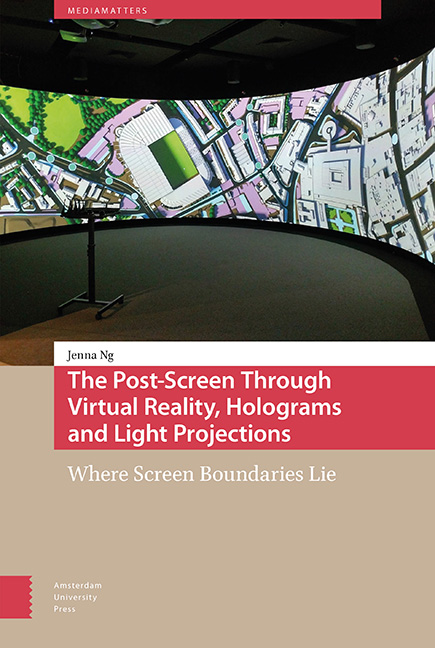 The Post-Screen through Virtual Reality, Holograms and Light Projections
The Post-Screen through Virtual Reality, Holograms and Light Projections Book contents
- Frontmatter
- Dedication
- Table of Contents
- Acknowledgements
- Introduction
- 1 Screen Boundaries as Movement
- 2 Leaking at the Edges
- 3 Virtual Reality: Confinement and Engulfment; Replacement and Re-placement
- 4 Holograms/Holographic Projections : Ghosts Amongst the Living; Ghosts of the Living
- 4A (Remix) True Holograms: A Different Kind of Screen; A Different Kind of Ghost
- 5 Light Projections: On the Matter of Light and the Lightness of Matter
- Conclusion/Coda
- Index
5 - Light Projections: On the Matter of Light and the Lightness of Matter
- Frontmatter
- Dedication
- Table of Contents
- Acknowledgements
- Introduction
- 1 Screen Boundaries as Movement
- 2 Leaking at the Edges
- 3 Virtual Reality: Confinement and Engulfment; Replacement and Re-placement
- 4 Holograms/Holographic Projections : Ghosts Amongst the Living; Ghosts of the Living
- 4A (Remix) True Holograms: A Different Kind of Screen; A Different Kind of Ghost
- 5 Light Projections: On the Matter of Light and the Lightness of Matter
- Conclusion/Coda
- Index
Summary
Abstract
This chapter explicates light projections as the third instantiation of the post-screen. The chapter's argument premises on light being the matter of light, namely, light as transformational in the convertibility between materiality and immateriality; matter and energy; rigidity and fluidity, whereby the corporeal is not only rendered impalpable but – its body energized, vitalized and volatile – turned inside out; consumed; deposed. The chapter thus argues for the post-screen through contemporary light projections and projection mapping technologies as the transformation of a variety of surfaces – the urban (e.g. building facades); the amorphous (e.g. water droplets and ash); the biological (e.g. bodies and faces) – giving rise not only to dynamic interrelations between materiality and immateriality, but also a radical convertibility between matter, energy, solidity, mass, and body that signals a moment of media history today.
Keywords: light projections; projection mapping; energy; mass; materiality; Immateriality
The City Rises
In 1910, the Italian painter and sculptor Umberto Boccioni completed his painting, The City Rises. A monumental work spanning almost ten feet across, it is a major statement of Italian Futurism and its main themes: technological progress, speed, energy, movement, violence, destruction and youth. Boccioni's city rises with the relentless drive for modernization that coloured the Futurist movement, its vision writ large across the smokestacks and construction scaffolding in the painting's background as, in the foreground, human (read as male) labour harness horses and machines towards their dream of industrial and technological development.
But it is the painting's light that catches my attention. Boccioni uses the technique of Divisionism which separates colour for optical interaction to achieve maximum luminosity. His rapid directional brushstrokes and the brilliant colours cast across the painting emphasize the power, dynamism and destructive promise of the rising city. But light also represents several beliefs held by Boccioni and Filippo Tommaso Marinetti (who led the Futurist movement and authored its first manifesto). One of these was how, following “recent scientific and pseudoscientific theories of matter,” such as those by Gustave Le Bon's The Evolution of Matter (1905), a text well known to the Futurists, the structure of matter could “dissociate” into energy.
Information
- Type
- Chapter
- Information
- The Post-Screen through Virtual Reality, Holograms and Light ProjectionsWhere Screen Boundaries Lie, pp. 207 - 252Publisher: Amsterdam University PressPrint publication year: 2021